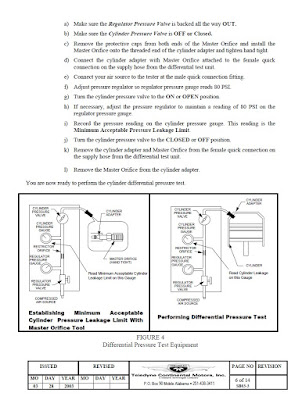The FAA requires a Compression or Leak Down Test. (Aircraft guys call it a "compression" test, but in fact the required inspection is a "leak down" test requiring compressed air and a gauge setup to measure the pressure drop due to "leakage" of air pressure past the piston rings and/or valves.)
Here is a link to a video about the leak down test:
Here is an informative article. Link plus copy below.
The other important information is the Continental Service Bulletin that was the first recommending the use of a borescope. And, the use of a Master Calibration Tool when doing the leakdown test. Leakdown, Borescope and Oil Analysis should give you a sound preventive maintenance program for your engine.
The TCM Bulletin is available with a link at Aircraft Spruce for the leak test unit with built in Master Calibration.
https://www.aircraftspruce.com
In addition to engine "condition" inspection via leak down tesing, borescope viewing, and oil analysis, along with checking/cleaning the oil and gascolator screens, part of the engine inspection includes checking the mag timing.
TCM SB on mag timing
Lots written about finding TDC with a degree wheel. Many old pros trust the timing marks on the crank flange lined up with the bottom engine case seam. See above.
In any case, use a timing light to determine when mag points open. (Be sure to trip the impulse couplers--the 0-200 on N998SC has an impulse coupler on both mags.
Info about that oil screen. The 0-200A engine comes with a "full flow" oil filtration screen in a housing that also provides the mounting for the oil temperature probe. Many have modified the engine to accept a spin on disposable automotive type oil filter.
Although these spin on filters do have the ability to remove more small particles, they are not anywhere the "perfect" solution that many think they are.
AOPA article: "A test conducted by the Milwaukee School of Engineering's Fluid Power Institute showed that a conventional Champion spin-on filter was successful in removing 100 percent of the particles down to 60 microns. (One thousandth of an inch equals 25.4 microns.) By 20 microns, the Champion was able to stop only 30 percent of the particles. By comparison, a standard Lycoming screen stopped just 49.2 percent of the 60-micron particles and 11.5 percent of the 20-micron pieces. A typical Continental screen posted similar results, although it was worse with larger pieces but better with smaller ones."
Considering that bearing clearances are in the 40-60 micron size, removing 100% of the 60 micron and larger size is a clear advantage---EXCEPT, these filters must have a relief valve which is wide open when the oil is cold, and/or when the filter is clogged. If a spin on filter is used, it is still advisable to run the screen, and clean it every oil change---although many remove the screen. If the screen is removed, the opening of the relief valve subjects the engine to worse conditions than those with the screen only. And, the risk of oil leaks increase with the spin on filter. Finally, as a general rule of thumb on full flow oil filters--the more filtration, the more pressure drop--so the spin on filter may result in lower oil pressure to the bearings, or no filtration.
Keep in mind that research indicates that 60% of engine wear occurs from particle sixe in the 5-20 micron size that is not 100% removed with a spin on filter. So, if maximizing engine life is the goal---changing oil often is the best solution.
One should note that racing engines use screens for oil filtration. Although the possibility of increased wear using a screen only exists, there is less risk of leaks and less risk of the zero filtration scenario with a spin on filter when the relief valve opens.
Under "normal" conditions, with oil changes every 25 hours or less, and with a regular oil analysis program, running the screen only is probably a good solution and perhaps better than running the spin on with oil changes only every 50 hours without an oil analysis program. If you want to "protect" your engine--change oil more often!






















No comments:
Post a Comment